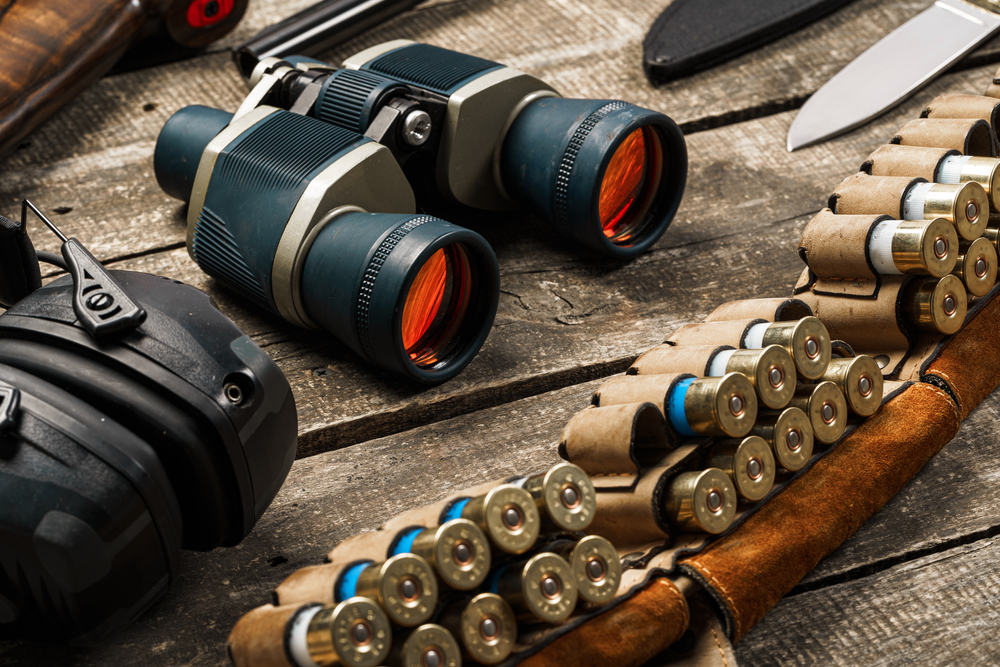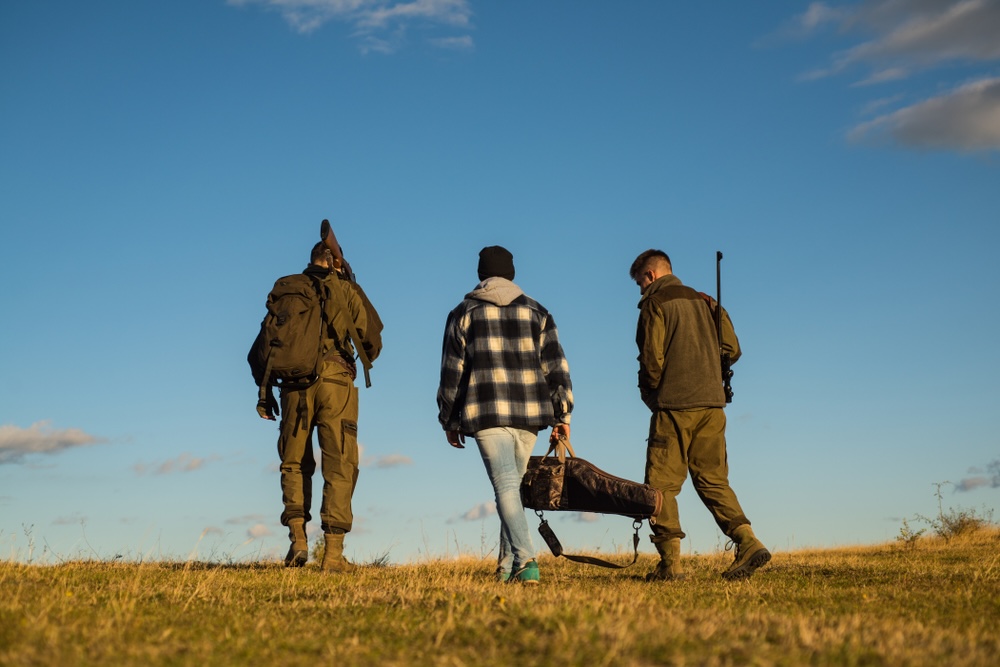Part of what makes hunting so exciting is how different it can be from season to season and from region to region.
Depending on where you live, you may have to store your hunting gear during the off-season. Or you might need some hunting gear organization tips to guide your transition as you swap between gear from hunting season to hunting season.
Either way, there’s no doubt you’ll want to keep your boots, hunting clothes, and hunting gear clean, dry, and scent-free in between uses.
But we don’t all have a spare room or climate-controlled shed we can use as our own private hunting gear storage facility. And even the toughest hunting gear on the market won’t last forever, especially if it’s not stored properly.
Our guide will give you all the hunting gear storage hacks, tips, and tricks you’ll need to be sure your hunting equipment lasts long and stays ready for action.
We’ll share tips on hunting clothes storage aimed at keeping your hunting clothes scent-free. Whether you’ve got a spare room, a hunting gear closet, or are using a storage unit as your hunting station, we’ll break down the best ways to store and organize your hunting gear.
Then, we’ll take a look at how our self-storage locator tool can help you obtain your own private hunting storage between your house and your favorite hunting spot for cheap!
Before we get too far ahead of ourselves, let’s take a look at the best options for hunting gear storage.
Best Options for Hunting Gear Storage

The process of storing your hunting gear may vary depending on where you’re storing it. While some of your recreational camping gear can get shoved back into place as soon as you get home from the trip, your hunting gear requires special priority.
In this section, we’ll cover our suggestions for setting up a hunting gear room at home, setting up a hunting closet, and using a self-storage unit as a hunting gear storage solution.
But first, regardless of where you’re storing it, you’ll need to prep your hunting clothes for storage starting as soon as you get back from the hunt.
This may seem like a boring step worth skipping, but trust us, even the toughest gear that’s built to last needs proper care and storage preparation. Remember, the more efficiently you store your gear, the more ready it is for the wild, and the more you can focus on the adventure when the time comes.
The first step is washing and drying your hunting clothes and packing them into storage containers or accessory totes. Avoid keeping the freshly cleaned clothes in damp places to prevent mildew from stinking up your gear.
How to Prep Your Hunting Gear for Storage
Before we move into where to store your gear, let’s take a closer look at how to prep your hunting gear for storage. There’s nothing worse than getting ready to meet the crew at 5 am only to realize your gear all smells like the inside of a neglected pickup truck.
Here’s a step-by-step guide on how to wash and prep your hunting clothes for storage:
- Rinse: As soon as you get back from your hunt, rinse those mud-drenched and sweat-covered hunting clothes with a hose. This prevents all the dense dirt from building up in your washing machine and passing from one piece of clothing to another.
- Wash with scent-free detergent only: This may seem basic, but many a good hunter has failed because their spouse washed their gear with lavender and orange peel-scented soaps that deer stay far away from. Keeping your hunting clothes scent-free starts with thoroughly washing them in the washer with scent-free detergent.
- Don’t use hot water: Wear your hunting clothes in either cold or warm water. Hot water can shrink some of the fabrics used to enhance the clothing’s durability, weakening the gear’s integrity in the process.
- Don’t use the dryer: Again, just like with the hot water, some of the most resilient hunting gear in the market uses fabrics that aren’t dryer-safe. Not only is it susceptible to shrinking, but drying also risks altering the shape of the clothing. Hang your hunting clothes and let them air dry. Be sure they’re totally dry before you store them.
- Don’t store your boots dirty: Dirt contains moisture and corrosive minerals that can eat away at your boots’ integrity if left on them for an extended period. Rather than storing your boots dirty, wipe them down with a damp cloth and a small amount of scent-free soap. Once they’re dirt-and-mud-free, air dry your boots until they’re dry on the inside and on the outside. Be sure not to store your boots while they’re still damp.
Before we move on, let’s make a quick note. It’s important to remember that there’s no foolproof method of keeping hunting clothes scent-free. They pick up your human scents as you wear them. Think of scent-free as a scale. If you control all the elements you can, you’re more scent-free than the hunter who washes their body with lavender soap, uses scented oils to polish their boots, and washes their gear in citrus-scented laundry soap. The goal here is to be as scent-free as possible by following our tips and tricks.
Setting Up a Hunting Gear Room at Home
You may have a garage you can convert to a hunting clothes storage room, or maybe you have a basement or attic that’s not being used.
- You want a private room you can use to store your hunting gear away from your regular clothes, which pick up scents from your kitchen, restaurants, your job, etc.
- You also want a moisture-free, climate-controlled room. Extreme temperature changes can change the shape of some of your gear. And moisture and humidity foster mildew and mold growth and cause corrosion.
- The ideal hunting storage room already has a closet or wardrobe system in it, but you can put an external wardrobe with a hanging rod in there if that’s not the case.
Once you’ve got your hunting gear storage room picked out, clean it thoroughly with scent-free cleaning product and air it out until there’s no residual moisture.
Our next step is fashioning a hunting gear organization system. You can do this by installing adjustable steel-frame storage racks with wire shelves. You can also build your own shelving system, but we suggest metal shelving that’s easier to clean and disinfect since wood is porous and holds moisture and smell.
Whichever type of shelves you settle on, we suggest taking advantage of vertical space. Shelves let you organize your hunting accessory totes vertically without resorting to stacking them, so you don’t have to relocate every bin when it’s time to get to the bottom of the stack.
Line the empty wall space of your hunting gear storage room with multi-drawer storage carts. When it comes time to organize your duck calls, dear whistles, multi-tools, and other smaller accessories, these portable drawer systems are an asset.
Hang your base layers and outerwear on the rod in your wardrobe closet, and add an ozone machine inside the closet to really absorb any leftover scents.
When it comes to storing your guns, bows, knives, and other weapons, we always suggest installing a double-locked gun case in your hunting room, preferably one with a high shelf to keep your ammo on. We recommend keeping the two keys to your double locks in separate locations for extra security and keeping at least one of the keys in a secure safe. And, if you opt to keep both keys in a safe, we can’t stress enough the importance of keeping them in two different safes with two different combos.
Setting Up a Hunting Closet
Those of us who don’t have an entire room dedicated to hunting gear storage can build out a hunting closet. If you don’t have a spare closet in your house that suits your hunting gear needs, you can order external “hunting closet” options online that you can put together yourself and set against a wall.
You’ll want a hunting gear closet with a center rod you can use to hang your base layers and outerwear, as this helps them retain their shape and keeps them air out. If you hunt in multiple seasons, you can organize your hanging hunting clothes in order from the most lightweight to the heaviest winter gear. This also lets you scroll through your clothing options on the fly so you can find the gear you need fast,
Wardrobes and closets that close are ideal for keeping the household smell off your gear. Again, you can throw an ozone machine in the hunting gear closet to keep moisture and scents filtered off of your hunting clothing.
If you don’t have a closet you can convert into your gear storage closet, there are external wardrobe units you can order online. That said, ordering a hunting wardrobe can be costly, and you don’t always know what you’re getting, especially when you find deals. We suggest reading through reviews and connecting with other hunters in forums to find the best wardrobe for your budget.
Or, you can find a climate-controlled storage unit for cheap and have all the space you need to keep your hunting clothes scent-free and prolong the life of your hunting gear.
Offsite Hunting Storage: Using Self-Storage Unit as a Hunting Gear Storage Solution
While there are some things we don’t suggest storing in a storage unit, converting a unit into a hunting gear storage room is an ideal way to use self-storage—especially for those already considering using a storage unit or shed for outdoor gear. Regardless of whether you’re a seasonal hunter or swap gear throughout the year, a climate-controlled self-storage unit gives you the space you need to keep your hunting gear organized and scent-free.
Harsh cold and humid heat can do a number on your gear, which makes most of our personal garages a no-go when it comes to hunting gear organization options.
And it’s not just the shape and insulation of your jacket we’re guarding here. Climate-controlled self-storage units protect your optical and electronic equipment from permanent damage. Extreme temperature shifts can warp and crack your hunting gear, such as:
- Leather boots and gloves
- Fabric hunting apparel
- Multitools with metal components
- Fishing gear, including fishing rods and reels
- Decoys and duck calls
- Binoculars
- Trail cameras
- Trail camera gear
- Electronics, like GPS devices and range finders
A storage unit is our top choice for hunting gear storage because it gives you enough space to implement a variety of organization strategies. You can test different organization methods and tweak your process year after year.
A storage unit also makes maintaining your off-season hunting gear easier, especially if you design your customized gear storage layout with maintenance and seasonal gear changes in mind.
A climate-controlled storage unit with an ozone machine inside protects your gear from clinging odors and prevents the cycle of contracting and expanding that wears your gear down over time.
Hunting Gear Organization

Optimizing your hunting gear storage situation starts with assessing the reality of the various storage options available. For example, you might feel like it makes more sense to store your hunting gear in large storage totes so you don’t need to buy as many.
We suggest using smaller storage totes to help you stay more organized so you’re not digging through a massive plastic bin looking for a pair of hunting socks. To this same point, clear bins let you see the contents before you open them. And don’t be a hero–once your bins are thoroughly organized, label them with a label maker or with masking tape and a marker.
Then, install metal racks to organize your totes. That way, you don’t have to stack them all on top of each other and unstack them one by one when you need to get something out of the bottom tote.
Rather than stuffing all your clothes in totes and having to dig through them, we suggest hanging your clothes and using those smaller totes for optics, electronics, and accessories. This keeps you from having to toss your hunting clothes on the floor while you’re trying to find a pair of gloves or your trail cam.
Finally, once you’ve got your shelving installed, your bins organized and labeled, and your clothes hung in your wardrobe, make a map or diagram of your organization system. Laminate your cheat sheet, leave it on a clipboard, and use some wire or string to attach the clipboard to the shelf unit.
With your gear organized and labeled and your diagram in place, you can find what you need on the diagram first and then go right to it instead of digging through bin after bin.
Pro tip: Store your heavier totes on the bottom of the shelves and the lighter gear up top.
Must-have Products and Containers for Hunting Gear Storage
When it comes to hunting clothes storage, there are some must-have products we suggest you buy. We’ve already covered a lot of these, but here’s a convenient list reviewing all the products we consider non-negotiable when setting up a hunting gear storage room or closet:
- Small clear storage totes: Plastic storage bins guard your hunting gear against dust, moisture, pests, and scents. We suggest keeping gear that’s vulnerable to mice and bugs in your small totes, like tent chords and backpacking meals. Smaller totes help you stay organized and prevent you from having to go through large bins. And we suggest clear totes so you can see what’s inside before you open it up.
- Steel-framed adjustable shelves: Organizing your storage totes onto shelves means you don’t have to unstack and re-stack them every time you need to access our gear. We suggest steel-frame wire shelving units for a few reasons. First, metal is easier to clean and sanitize. Wooden shelves are porous, meaning they hold moisture and scents that can contaminate your gear. Wire shelves also make it easy to hang hooks off, allowing you to hang your turkey vests, backpacks, and duffle bags off the side of the shelves to free up space.
- Multi-drawer organizer carts: You can wheel these portable drawers right against the wall or against the side of your shelving unit. Multi-drawer organizer carts typically have between three and five drawers. You can install compartments to organize the drawers to organize them more. These portable drawer systems are a great place to store smaller hunting gear items like hand tools, calls, sprays, scents, sunscreen, hand warmers, etc. Organizer carts are also a great place for small hunting clothes storage–hats, gloves, socks, and even gaiters all fit conveniently inside their drawers.
Storage Methods: Hunting Gear Organization Ideas
Once you’ve got your hunting gear storage space figured out, it’s time to start the trial-and-error process of storing your clothes, boots, and equipment. Some of these hunting gear organization ideas are intended to save space, while others are methods of prolonging your gear’s life and keeping it scent-free.
- Compress your out-of-season hunting clothes in vacuum-sealed bags to keep them smelling fresh and natural and prevent them from absorbing the scent of the plastic bin. NOTE: Be sure you wash your clothes thoroughly and dry them before you seam them up, or they’ll fester with mildew.
- Line the bottom of your containers with dried pine needles or natural outdoor scent wafers so your hunting gear smells like the woods of your favorite hunting spot.
- Keep earth-scent wafers or baking soda in your plastic bins to help absorb moisture, keeping your hunting clothes scent-free and your gear free from corrosion.
- Store your hunting gear in a climate-controlled storage space, like a climate-controlled storage unit, closet, renovated basement, or spare room. Spaces like the shed or garage that are exposed to rapid temperature shifts and mixtures promote mildew growth when you are hunting clothes and wear and tear on your gear.
- Store your commonly used hunting clothing items, like your pants and jackets, in scent-controlled gear bags. Make sure they’re clean and dry when you put them up. That way, on the day of the hunt, you can grab your gear bags, toss them in your pack, and jump in the truck.
- Wash your rubber boots after use and air dry them before storing them in a plastic container. Throw some baking soda into the bottom of the container to absorb any leftover moisture and scents.
- Hang your clothes up in a natural outdoor area the day before your hunt. This not only helps to air out their indoor smells but also attracts natural outdoor scenes, especially if you can hang them up in a secluded forest area.
- Organize your gear in a way that gives you quick access to the stuff you use the most. You’ll also want the space to clean and maintain the gear you haven’t used in a while to ensure it’s in tip-top shape as soon as you need it.
One of the reasons we suggest using a climate-controlled self-storage unit is that the extra space streamlines the gear swaps and routine hunting gear maintenance process. Let’s examine a few more fast hunting gear storage hacks.
Hunting Gear Storage Hacks
Now that you’ve got a good idea of how to set up your space, where to set it up, and which storage methods to employ, let’s take a look at hunting gear storage hacks that’ll keep your stuff neat, clean, organized, and ready for action.
One method is to sort your gear by its use case or purpose. For example, you might keep your frequently used hunting clothes like gloves, pants, and jackets in the wardrobe so they’re easy to find and ready to grab. But rubber rain boots, extra scent-proof bags for food storage, tree stands, and camping gear for overnight hunts might go up on a higher shelf.
You could also organize your hunting gear storage system by season. Your lighter base layers and warm-weather clothing could go on one side of your wardrobe, while your heavy cold-weather gear can go on the opposite side.
We’ll share some more hacks about finding the ideal hunting gear storage unit on the cheap down below. First, let’s take a look at a few more last-minute tips and tricks.
Tips and Tricks for Storing Hunting Gear
Here are a few last-minute tips on how to store hunting clothes and hunting gear:
- Give your gear some room to breathe: We suggest you avoid stuffing your plastic containers full to bring with your hunting gear. This not only risks damaging the gear, but overstuffing the bin minimizes the amount of fresh air that can fit inside. Giving your hunting gear room to breathe ensures they’re fresh and ready to go when the next hunt rolls around.
- Pack your gear in the reverse order: For example, if your rubber boots are the last thing you’ll take out and put on when you’re leaving for the hunt, they can be packed first since you’ll get to them last. If your base layer is the first thing you put on, pack it last so it’s right on top of the tote or hanging right in front of your wardrobe, where it’s easy to grab first.
- Keep a storage system diagram, checklist, or key handy: Once you organize your bins, make a storage inventory checklist of everything that’s in it and take it to the top of the bin. As we mentioned earlier, we suggest creating a diagram or at least a master checklist that contains the order in which your bins are organized and the contents of each.
- Designate a spot for gear maintenance: You’ll want to set up a small table with a chair or leave a designated shelf space empty to unpack your off-season gear, check on it, air it out, replace batteries, clean your rifle, etc.
How Selfstorage.com Can Help You Find the Ideal Hunting Gear Storage Unit
The ideal hunting gear storage space starts with careful preparations and creating an organized system. Clear storage containers, steel shelving units, and a hanging wardrobe for hunting clothes storage help save space and make it easy to find what you need.
You’ll want to make sure you’re taking the extra steps for keeping your hunting clothes scent-free and prolonging the life of your gear. Those steps include maintaining consistent temperatures and preventing moisture and odor from contaminating your storage space.
You can reduce moisture and odor contamination by using ozone machines, backing soda, and natural scent wafers. But when it comes to regulating moisture, climate, and temperature, you’ll need to make sure your dedicated hunting room is climate-controlled–a shed or a garage leaves your gear susceptible to corrosion, warping, mold, and other types of damage.
But we don’t all have a spare room or extra wake in the closet we can dedicate to hunting gear storage, especially considering that you need space to swap out season gear and maintain the off-season gear that’s been stashed away for months on end.
Our advice? Book a climate-controlled storage unit and convert it to a dedicated hunting gear storage space following the steps we outlined in this guide. A climate-control self-storage unit creates the ideal environment, protecting your gear against pests, moisture, corrosion, and the dramatic temperature changes that all work together to eat through even the most durable hunting gear.
There’s no doubt about it: improper storage will shorten the life of your gear, and it can contaminate it with odors and mildew that will send deer running in the opposite direction. A self-storage unit gives you the space and climate control you need to implement the ideal hunting gear storage space.
But not all storage units are created equal, mind you. Some aren’t climate-controlled, and others lack security cameras or the 24-hour access that lets you leave for your hunt at 3 am.
But don’t worry. Selfstorage.com is here to help you select the ideal right storage space. Just punch your zip code into our handy storage search tool to find a storage unit between your house and your favorite hunting spot.
Our site searches through over 20,000 storage facilities nationwide. Our tool lets you filter your results based on the search parameters you set. Narrow your results based on location and amenities like climate control and 24-hour access.
SelfStorage.com lets you compare prices and unit sizes and reserve your storage unit for free in minutes. No commitment and no credit card required!
Frequently Asked Questions
What should I store my hunting clothes in?
We suggest hanging your frequently used hunting clothes in a wardrobe closet with an ozone machine. Store your seasonal clothes in plastic totes or vacuum-sealed bags. These keep out moisture, dirt, and pests while maintaining scent control. Label each storage container and use clear containers clearly for easy access.
How do I store hunting gear in my truck?
Store hunting gear in your truck using plastic bins or storage totes. Organize your items into bins by type and keep the contents dry. Label each bin for easy access. Install a truck bed drawer system for additional secure hunting gear storage. Use tie-downs to keep your drawers and bins stable.
How do I store hunting clothes scent free?
Wash your hunting clothes with scent-free detergent and let them air dry completely. Then store in sealed plastic totes or vacuum bags. Add earth-scent wafers or pine needles for natural scents. Never wash your hunting clothes with typical scented laundry soaps.
What is the best storage for hunting clothes?
We suggest storing hunting clothes in climate-controlled indoor spaces like a climate-controlled storage unit, spare room, walk-in closet, or basement. Use a wardrobe closet or plastic totes, and consider adding an ozone machine or natural scent wafers for scent control.
How do you store hunting clothes in the garage?
We suggest avoiding storing your hunting gear in your garage unless the garage is climate-controlled. Garages experience extreme temperature fluctuations that can warp and damage gear, and the dampness can cause mildew. Use climate-controlled indoor spaces like storage units or walk-in closets.







